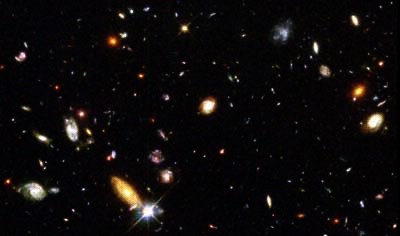|
The universe is a large place. It is composed of billions of galaxies that are moving apart from each other. This implies that at some time billions of years ago, they must have been a lot closer together. In fact, astronomers believe that the universe originated with a gigantic explosion more than 20 billion years ago, called the 'Big Bang'. As the matter from this explosion moved outward, it coalesced into the galaxies of stars we can see ... hundreds of billions of galaxies! Remember too that each galaxy, like our own Milky Way, contains hundreds of billions of stars! When you look at distant stars in our own galaxy, or the galaxies beyond, you are seeing them the way they looked when the light left them. Since light can take many years to travel from star to star, and many billions of years to travel from the distant galaxies, we are seeing the universe the way it looked billions of years ago when we look at these distant galaxies in a telescope! Asking the question 'how far can we see' is really the same as asking 'how far back into the past can we see' So how far back can we see? The answer is amazing! Our best telescopes for visual viewing, the Hubble space telescope and now the James Webb space telescope, both of which are in orbit, can see a distance of at least 13 billion years, or, in other words, can see galaxies that were formed a mere billion years after the birth of the universe!  The picture above shows several hundred never-before-seen galaxies, visible in one of the 'deepest-ever' views of the universe, made with NASA's Hubble Space Telescope. Besides the classical spiral and elliptical shaped galaxies, there is a bewildering variety of other galaxy shapes and colors, that are important clues to understanding the evolution of the universe. Some of the galaxies may have formed less that one billion years after the Big Bang. This image represents an extremely small part of the sky, just 1/100 of the diameter of the moon. This is so narrow, just a few foreground stars in our own Milky Way galaxy are visible (the brightest, at the bottom, left off center, for example). The menagerie of far more distant galaxies includes some nearly four billion times fainter than the limits of human vision. Though the field is a very small sample of sky area, it is considered representative of the typical distribution of galaxies in space because the universe, statistically, looks the same in all directions. |